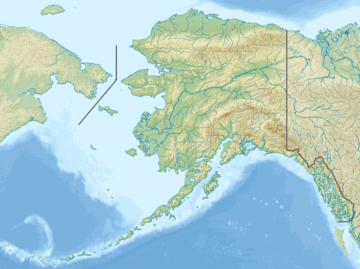Scotch Cap Light
|
1950 lighthouse | |
 Alaska | |
| Location |
Unimak Island Alaska United States |
|---|---|
| Coordinates | 54°23′40″N 164°44′41″W / 54.39444°N 164.74472°WCoordinates: 54°23′40″N 164°44′41″W / 54.39444°N 164.74472°W |
| Year first constructed |
1903 (first) 1940 (second) 1950 (third) |
| Year first lit | date n/a (current) |
| Automated | 1971 |
| Construction |
metal skeletal tower (current) ) wooden tower (first) concrete tower (second) masonry building with short tower on the roof (third |
| Tower shape |
square pyramidal skeletal tower with balcony and light (current) octagonal prism tower (first) square parallelepiped tower (second) short tower with light (third) |
| Height | 26 feet (7.9 m) |
| Focal height | 110 feet (34 m) |
| Original lens | Third-order Fresnel lens |
| Light source | solar power |
| Characteristic | Fl W 6s. |
| Admiralty number | G6912 |
| ARLHS number | ALH-016 |
| USCG number | 6-1220 |
| Managing agent |
United States Coast Guard[1] [2] [3] |
The Scotch Cap Light is a lighthouse located on the southwest corner of Unimak Island in Alaska. It was the first station established on the outside coast of Alaska.
History
In 1903, the Scotch Cap Light was built. The original lighthouse was a 45-foot (14 meter) wood tower on an octagonal wood building. According to the Coast Guard Historian's Office, the lighthouse was witness to several ship wrecks.[4]
In 1909, the cannery supply ship Columbia wrecked. The 194 crew members were guests of the keepers for two weeks before a rescue ship could remove them. In 1930, the Japanese freighter Koshun Maru became lost in a snowstorm and beached near the light. In 1940, a new concrete reinforced lighthouse and fog-signal building was erected near the site of the original lighthouse. In 1942, the Russian freighter Turksib wrecked near the station. The 60 survivors lived at the station for several weeks because rough seas prevented a rescue ship from reaching the station.
The 1940 aid to navigation was the "twin" of the Sand Hills Light in Michigan's Keweenaw Peninsula, replicating much of its design.[5]
In 1945, Anthony Petit was assigned the lighthouse keeper to the Scotch Cap Light as the head of a five-man crew. All of the men were killed on April 1, 1946 during the 1946 Aleutian Islands earthquake, when a massive tsunami struck the station, destroying it.[6][7] This was the worst disaster to ever befall a land-based Coast Guard light station.[8][9] The United States Coast Guard has named a Keeper class buoy tender USCGC Anthony Petit (WLM-558) based in Ketchikan, Alaska in his honor.[10]
In 1946, in the wake of the tsunami disaster, a temporary unwatched light was established. The new permanent structure was completed in the early 1950s, and the temporary light was discontinued. The lighthouse was automated in 1971. A skeletal tower replaced the 1950s structure, and the fog signal was discontinued.[4]
Gallery
- Original 1903 Lighthouse
- 1940 Lighthouse
See also
References
- ↑ Cape Spencer The Lighthouse Directory. University of North Carolina at Chapel Hill. Retrieved 8 June 2016
- ↑ Alaska Historic Light Station Information & Photography United States Coast Guard. Retrieved 8 June 2016
- ↑ Scotch Cape Light Lighthouse Explorer. Retrieved 8 June 2016
- 1 2 "Historic Light Station Information and Photography: Alaska". United States Coast Guard Historian's Office. Retrieved 2008-10-26.
- ↑ Sand Hills Light Bed and Breakfast, Exploring the North.
- ↑ DrGeorgePC website with photos
- ↑ Baker, James, Tsunami at Scotch Cap, March 2005, Lighthouse Digest.
- ↑ Dowling Dennis, The Demise Of Scotch Cap Light Station.
- ↑ Rowlett, Russ. "Lighthouses of Alaska". The Lighthouse Directory. University of North Carolina at Chapel Hill.
- ↑ U.S.C.G.C. Anthony Petit.
External links
| Wikimedia Commons has media related to Scotch Cap Lighthouse. |
- United States Coast Guard
- Anthony Petit biography
- A Land-Locked Coastie — Scotch Cap Light Station
- An artist's depiction showing the tsunami wave just before impact
- Scotch Cap Lightstation Tsunami Disaster memorial page
